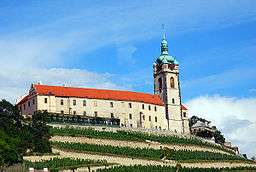Mělník
| Mělník | |||
| Town | |||
 | |||
|
|||
| Country | Czech Republic | ||
|---|---|---|---|
| Region | Central Bohemian | ||
| District | Mělník | ||
| Commune | Mělník | ||
| Rivers | Elbe, Vltava | ||
| Elevation | 215 m (705 ft) | ||
| Coordinates | 50°21′7″N 14°28′30″E / 50.35194°N 14.47500°ECoordinates: 50°21′7″N 14°28′30″E / 50.35194°N 14.47500°E | ||
| Area | 24.97 km2 (9.64 sq mi) | ||
| Population | 19,201 | ||
| Density | 769/km2 (1,992/sq mi) | ||
| First mentioned | 1274 | ||
| Mayor | Ctirad Mikeš | ||
| Timezone | CET (UTC+1) | ||
| - summer (DST) | CEST (UTC+2) | ||
| Postal code | 276 01 | ||
  Location in the Czech Republic | |||
| Wikimedia Commons: Mělník | |||
| Statistics: statnisprava.cz | |||
Mělník (Czech pronunciation: [ˈmɲɛlɲiːk]; German: Melnik) is a town in the Central Bohemian Region of the Czech Republic. It lies at the confluence of the Labe and Vltava rivers, approximately 35 km (22 mi) north of Prague. The town is part of the Prague larger urban zone. The region belongs to the most important agricultural areas of the Czech Republic. The main agricultural produce are fruits, vegetables, potatoes, corn, sugar beet and wine.
History
In the 5th and 6th century many Slavonic tribes lived here, and the tribe of Pšovans created its main settlement in Mělník. Saint Ludmila (the grandmother of the Saint Wenceslas), who married the Bohemian prince Bořivoj, belonged to this tribe. Coins of the princess Emma are the first demonstration of the existence of Mělník. In November 1274 Mělník gained the statute of town from king Ottokar II of Bohemia and later became a dowry town belonging to queens of Bohemia.
Landmarks
The Mělník castle belongs to the most important sights of this town. The castle is built in the Renaissance style. Below the castle there are large wine cellars. Confiscated by the communists, it has been restored to its traditional owners, the princes of Lobkowicz.
The St. Peter and St. Paul's Church faces the Mělník castle. The church was rebuilt three times. The church is used primarily for religious functions, but everyone is able to look inside at the interior. The construction began at the turn of the 10th and 11th centuries. Starting in 2007 the public will be allowed access to the reconstructed church tower. There is a large and elaborate ossuary inside the church, which is a minor tourist attraction. Anthropologist Professor Jindrich Matiegka conducted research here between 1915-1919, during which he arranged the remains of 10-15,000 people.
Behind the church there is the building of the old school. There is a restaurant here today with a beautiful view of the river and Hořín park. Near the castle there is the Villa Carola where the town library is located, which is part of the Mekuc - Culture center of Melnik.
 The central area of the city
The central area of the city- Castle above the confluence of the Vltava and Labe
- Confluence of the Vltava and Labe
Wine-growing
96% of Czech wines are produced in the Moravian region. Around 875 wine production first expanded to Bohemia with villagers of Mělník husbanding its first vineyard. According to legend, the Great Moravian Prince Svatopluk sent the Bohemian Prince Bořivoj a barrel of wine to celebrate the birth of his son Spytihněv. Bořivoj's wife Ludmila sacrificed some of the wine to Krosyně (goddess of the harvest) while making a plea for abundant rain. Her wish came true, the crop was saved and Bořivoj and Ludmila planted the first Bohemian vineyards around Mělník. Their grandson Saint Wenceslas later learned how to cultivate vines in these vineyards and make wine. He is honored by Czech winemakers as Supremus Magister Vinearum (Supreme Burgomaster of the Vineyards) and every year at the end of September a wine festival is held in Mělník on the Feast of St. Wenceslas.
Mělník gives its name to the Mělnická wine region, one of the most northerly in Europe.
Industry
Mělník is one of the biggest river ports in the Czech Republic and a place of container transshipment.
International relations
Twin towns — Sister cities
Mělník is twinned with:
-
 Melnik, Bulgaria
Melnik, Bulgaria -
 Oranienburg, Germany, from 1974.
Oranienburg, Germany, from 1974. -
 Przeworsk, Poland
Przeworsk, Poland -
 Wetzikon, Switzerland
Wetzikon, Switzerland
References
External links
| Wikimedia Commons has media related to Mělník. |

